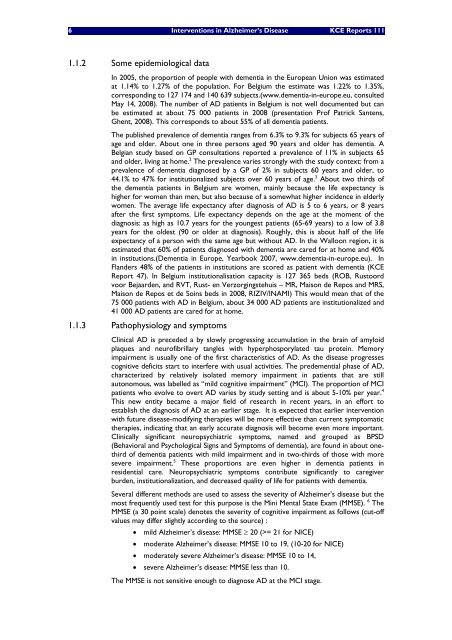Download the full report (112 p.) - KCE
Download the full report (112 p.) - KCE
Download the full report (112 p.) - KCE
You also want an ePaper? Increase the reach of your titles
YUMPU automatically turns print PDFs into web optimized ePapers that Google loves.
6 Interventions in Alzheimer’s Disease <strong>KCE</strong> Reports 111<br />
1.1.2 Some epidemiological data<br />
In 2005, <strong>the</strong> proportion of people with dementia in <strong>the</strong> European Union was estimated<br />
at 1.14% to 1.27% of <strong>the</strong> population. For Belgium <strong>the</strong> estimate was 1.22% to 1.35%,<br />
corresponding to 127 174 and 140 639 subjects.(www.dementia-in-europe.eu, consulted<br />
May 14, 2008). The number of AD patients in Belgium is not well documented but can<br />
be estimated at about 75 000 patients in 2008 (presentation Prof Patrick Santens,<br />
Ghent, 2008). This corresponds to about 55% of all dementia patients.<br />
The published prevalence of dementia ranges from 6.3% to 9.3% for subjects 65 years of<br />
age and older. About one in three persons aged 90 years and older has dementia. A<br />
Belgian study based on GP consultations <strong>report</strong>ed a prevalence of 11% in subjects 65<br />
and older, living at home. 2 The prevalence varies strongly with <strong>the</strong> study context: from a<br />
prevalence of dementia diagnosed by a GP of 2% in subjects 60 years and older, to<br />
44.1% to 47% for institutionalized subjects over 60 years of age. 3 About two thirds of<br />
<strong>the</strong> dementia patients in Belgium are women, mainly because <strong>the</strong> life expectancy is<br />
higher for women than men, but also because of a somewhat higher incidence in elderly<br />
women. The average life expectancy after diagnosis of AD is 5 to 6 years, or 8 years<br />
after <strong>the</strong> first symptoms. Life expectancy depends on <strong>the</strong> age at <strong>the</strong> moment of <strong>the</strong><br />
diagnosis: as high as 10.7 years for <strong>the</strong> youngest patients (65-69 years) to a low of 3.8<br />
years for <strong>the</strong> oldest (90 or older at diagnosis). Roughly, this is about half of <strong>the</strong> life<br />
expectancy of a person with <strong>the</strong> same age but without AD. In <strong>the</strong> Walloon region, it is<br />
estimated that 60% of patients diagnosed with dementia are cared for at home and 40%<br />
in institutions.(Dementia in Europe, Yearbook 2007, www.dementia-in-europe.eu). In<br />
Flanders 48% of <strong>the</strong> patients in institutions are scored as patient with dementia (<strong>KCE</strong><br />
Report 47). In Belgium institutionalisation capacity is 127 365 beds (ROB, Rustoord<br />
voor Bejaarden, and RVT, Rust- en Verzorgingstehuis – MR, Maison de Repos and MRS,<br />
Maison de Repos et de Soins beds in 2008, RIZIV/INAMI) This would mean that of <strong>the</strong><br />
75 000 patients with AD in Belgium, about 34 000 AD patients are institutionalized and<br />
41 000 AD patients are cared for at home.<br />
1.1.3 Pathophysiology and symptoms<br />
Clinical AD is preceded a by slowly progressing accumulation in <strong>the</strong> brain of amyloid<br />
plaques and neurofibrillary tangles with hyperphosporylated tau protein. Memory<br />
impairment is usually one of <strong>the</strong> first characteristics of AD. As <strong>the</strong> disease progresses<br />
cognitive deficits start to interfere with usual activities. The predemential phase of AD,<br />
characterized by relatively isolated memory impairment in patients that are still<br />
autonomous, was labelled as “mild cognitive impairment” (MCI). The proportion of MCI<br />
patients who evolve to overt AD varies by study setting and is about 5-10% per year. 4<br />
This new entity became a major field of research in recent years, in an effort to<br />
establish <strong>the</strong> diagnosis of AD at an earlier stage. It is expected that earlier intervention<br />
with future disease-modifying <strong>the</strong>rapies will be more effective than current symptomatic<br />
<strong>the</strong>rapies, indicating that an early accurate diagnosis will become even more important.<br />
Clinically significant neuropsychiatric symptoms, named and grouped as BPSD<br />
(Behavioral and Psychological Signs and Symptoms of dementia), are found in about onethird<br />
of dementia patients with mild impairment and in two-thirds of those with more<br />
severe impairment. 5 These proportions are even higher in dementia patients in<br />
residential care. Neuropsychiatric symptoms contribute significantly to caregiver<br />
burden, institutionalization, and decreased quality of life for patients with dementia.<br />
Several different methods are used to assess <strong>the</strong> severity of Alzheimer’s disease but <strong>the</strong><br />
most frequently used test for this purpose is <strong>the</strong> Mini Mental State Exam (MMSE). 6 The<br />
MMSE (a 30 point scale) denotes <strong>the</strong> severity of cognitive impairment as follows (cut-off<br />
values may differ slightly according to <strong>the</strong> source) :<br />
• mild Alzheimer’s disease: MMSE ≥ 20 (>= 21 for NICE)<br />
• moderate Alzheimer’s disease: MMSE 10 to 19, (10-20 for NICE)<br />
• moderately severe Alzheimer’s disease: MMSE 10 to 14,<br />
• severe Alzheimer’s disease: MMSE less than 10.<br />
The MMSE is not sensitive enough to diagnose AD at <strong>the</strong> MCI stage.

















